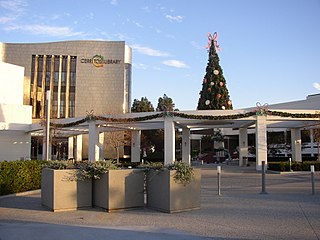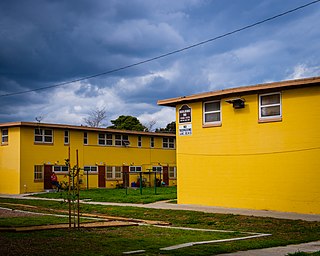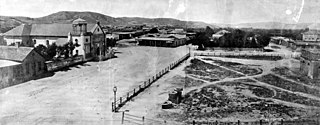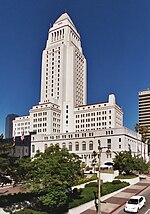
Los Angeles, often referred to by its initials L.A., is the largest city in the U.S. state of California. With a population of roughly 3.9 million as of 2020, it is the second largest city in the United States after New York City and one of the world's most populous megacities. Los Angeles is known for its Mediterranean climate, ethnic and cultural diversity, Hollywood film industry, and sprawling metropolitan area. The city of Los Angeles lies in a basin in Southern California, adjacent to the Pacific Ocean extending through the Santa Monica Mountains and into the San Fernando Valley. It covers about 469 square miles (1,210 km2), and is the seat of Los Angeles County, which is the most populous county in the United States with an estimated 9.86 million as of 2022.

Los Angeles County, officially the County of Los Angeles, and sometimes abbreviated as L.A. County, is the most populous county in the United States and in the U.S. state of California, with 9,861,224 residents estimated as of 2022. It is the most populous non–state-level government entity in the United States. Its population is greater than that of 40 individual U.S. states. At 4,083 square miles (10,570 km2) and with 88 incorporated cities and many unincorporated areas, it is home to more than one-quarter of California residents and is one of the most ethnically diverse counties in the United States. Its county seat, Los Angeles, is also California's most populous city and the second most populous city in the United States, with about 3.9 million residents.

Cerritos is a city in Los Angeles County, California, United States, and is one of several cities that constitute the Gateway Cities of southeast Los Angeles County. It was incorporated on April 24, 1956. As of 2019, the population was 49,859. It is part of the Los Angeles–Long Beach–Anaheim, California Metropolitan Statistical Area designated by the Office of Management and Budget.
Jordan Downs is a 700-unit public housing apartment complex in Watts, Los Angeles, California, next to David Starr Jordan High School. It consists of 103 buildings with townhouse style units ranging from one bedroom to five bedrooms. The complex is owned and managed by the Housing Authority of the City of Los Angeles (HACLA).

Nickerson Gardens is a 1,066-unit public housing apartment complex at 1590 East 114th Street in Watts, Los Angeles, California. Nickerson Gardens is the largest public housing development west of the Mississippi River and was the first home of many notable people, including Jazz Joy and Roy Global Radio host Roy O’Dell Gray, who, according to Hollywood insiders, is the first cousin of Mary Mary Super Producer Warryn Campbell.

Mar Vista Gardens is a housing project at 11965 Allin Street in Del Rey, a district of southwestern Los Angeles County, California near Culver City, bordering Ballona Creek. It is operated by the Housing Authority of the City of Los Angeles (HACLA).
Gonzaque Village is public housing project located in the Watts neighborhood of Los Angeles, California. It is operated by the Housing Authority of the City of Los Angeles. It was built in 1942 on 17.6 acres of flat land. Its 71 one-story buildings have 182 units housing 437 residents.
HOPE VI is a program of the United States Department of Housing and Urban Development. It is intended to revitalize the worst public housing projects in the United States into mixed-income developments. Its philosophy is largely based on New Urbanism and the concept of defensible space.

El Pueblo de Nuestra Señora la Reina de los Ángeles, shortened to Pueblo de los Ángeles, was the Spanish civilian pueblo settled in 1781, which by the 20th century became the American metropolis of Los Angeles. The pueblo was built using labor from the adjacent village of Yaanga and was totally dependent on local Indigenous labor for its survival.

The California Coastal Commission (CCC) is a state agency within the California Natural Resources Agency with quasi-judicial control of land and public access along the state's 1,100 miles (1,800 km) coastline. Its mission as defined in the California Coastal Act is "to protect, conserve, restore, and enhance the environment of the California coastline".

Parkmerced is a neighborhood in San Francisco, California, designed by architects Leonard Schultze and Thomas Dolliver Church in the early 1940s. Parkmerced is the second-largest single-owner neighborhood of apartment blocks west of the Mississippi River after Park La Brea in Los Angeles. It was a planned neighborhood of high-rise apartment towers and low-rise garden apartments in southwestern San Francisco for middle-income tenants. It contains 3,221 residences and over 9,000 residents, and is one of four remaining privately owned large-scale garden apartment complexes in the United States. The complex is located south of SFSU, west of 19th Avenue, and east of Lake Merced and the Harding Park Golf Club. The far western boundary of the neighborhood extends to Lake Merced Boulevard, and the neighborhood is popular with students and faculty at San Francisco State University because of its proximity. The property was purchased in October 2005 for approximately $687,000,000 by a joint venture between Stellar Management and Rockpoint Group from a JP Morgan Chase and Carmel Partners joint venture entity.
The Avalon Gardens is a public housing project located in the Green Meadows neighborhood of Los Angeles, California. It is one of the oldest housing projects owned by the Housing Authority of the City of Los Angeles.

San Jose, California, is the third largest city in the state, and the largest of all cities in the San Francisco Bay Area and Northern California, with a population of 1,021,795.
Aliso Village was a housing project in Los Angeles, California. It was built in 1942 and demolished 1999. The 29-acre (120,000 m2) parcel was replaced by Pueblo del Sol.
Pueblo del Sol is a housing project in Boyle Heights, Los Angeles, California. It is operated by the McCormack Baron Salazar management company.

Ramona Gardens is a public housing development in the Boyle Heights neighborhood of Los Angeles, California. It is operated by the Housing Authority of the City of Los Angeles. Currently and historically Latino, it is also the home of the Big Hazard street gang, connected to the Mexican Mafia, and has been the center of the illegal drug market in Southern California.

The Government of Los Angeles County is defined and authorized under the California Constitution, California law, and the Charter of the County of Los Angeles. Much of the Government of California is in practice the responsibility of county governments, such as the Government of Los Angeles County. The County government provides countywide services such as elections and voter registration, law enforcement, jails, vital records, property records, tax collection, public health, health care, and social services. In addition the County serves as the local government for all unincorporated areas.

Since about 1970, California has been experiencing an extended and increasing housing shortage, such that by 2018, California ranked 49th among the states of the U.S. in terms of housing units per resident. This shortage has been estimated to be 3-4 million housing units as of 2017. Experts say that California needs to double its current rate of housing production to keep up with expected population growth and prevent prices from further increasing, and needs to quadruple the current rate of housing production over the next seven years in order for prices and rents to decline.

The history of Los Angeles began in 1781 when 44 settlers from New Spain established a permanent settlement in what is now Downtown Los Angeles, as instructed by Spanish Governor of Las Californias, Felipe de Neve, and authorized by Viceroy Antonio María de Bucareli. After sovereignty changed from Mexico to the United States in 1848, great changes came from the completion of the Santa Fe railroad line from Chicago to Los Angeles in 1885. "Overlanders" flooded in, mostly white Protestants from the Lower Midwest and South.















